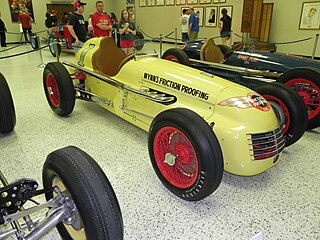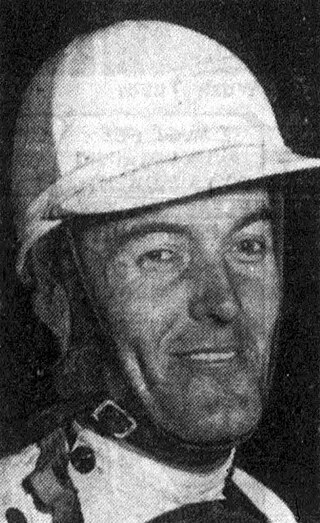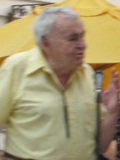
Rodger Morris Ward was an American racing driver best known for his open-wheel career. He is generally regarded as one of the finest drivers of his generation, and is best known for winning two National Championships, and two Indianapolis 500s, both in 1959 and 1962. He also won the AAA National Stock Car Championship in 1951.

The 34th International 500-Mile Sweepstakes was held at the Indianapolis Motor Speedway on Tuesday, May 30, 1950. The event was part of the 1950 AAA National Championship Trail. It was also race 3 of 7 in the 1950 World Championship of Drivers and paid points towards the World Championship. The event, however, did not attract any European Formula One drivers for 1950. Giuseppe Farina originally planned to enter, but his car never arrived. The Indianapolis 500 would be included on the World Championship calendar through 1960.

George Rice Chitwood, nicknamed "Joie", was an American racecar driver and businessman. He is best known as a daredevil in the Joie Chitwood Thrill Show.
Melvin Eugene "Tony" Bettenhausen was an American racing driver known primarily for his open-wheel career. He twice won the National Championship, doing so in 1951 and 1958. He also competed in stock cars, winning under AAA and USAC sanction.
Mike Nazaruk was an American racecar driver. He raced midget cars, sprint cars, and IndyCars. He was nicknamed "Iron Mike."
John Ashley Thomson was an American racecar driver. Thomson was nicknamed "the Flying Scot." He won several championships in midgets and sprint cars before competing in Championship Car racing. He won the pole position for the 1959 Indianapolis 500.

James Richard Davies was an American racecar driver in Champ cars and midgets. He was the second man to win three USAC National Midget Championships. When Davies won the 100-mile (160 km) AAA Championship race at Del Mar, California on November 6, 1949 – aged 20 years, 2 months, 29 days, he became the youngest driver to win a race in a major U.S. open wheel series, a record not broken until Marco Andretti won the IRL race at Sonoma, California in 2006. Davies raced AAA on a false birth certificate showing him older, and was racing illegally.
Willard Saulsbury "Bill" Holland was an American racing driver from Philadelphia, Pennsylvania. He won the Indianapolis 500 in 1949 and finished second in 1947, 1948 and 1950. He was runner up in the 1947 American Automobile Association (AAA) National Championship.
Henry Edwin Banks was an English-American racing driver. He competed in various disciplines of open-wheel motorsport. Banks is best remembered for winning the 1950 AAA National Championship, and for his later career as a USAC race official.

John Woodrow "Johnnie" Parsons was an American racing driver in the AAA and USAC Championship Car series. He was the 1949 AAA national champion, and won the 1950 Indianapolis 500.

Mel Kenyon is a former midget car driver. He is known as the "King of the Midgets", "Miraculous Mel" and "Champion of Midget Auto Racing." The Motorsports Hall of Fame of America says "Many consider him to be midget car racing's greatest driver ever."

Richard Frank Vogler was an American champion sprint car and midget car driver. He was nicknamed "Rapid Rich". He competed in the Indianapolis 500 five times, and his best finish was eighth in 1989.

Langhorne Speedway was an automobile racetrack in Middletown Township, Bucks County, near the borough of Langhorne, Pennsylvania, a northern suburb of Philadelphia.

Duane Claude Carter Jr., nicknamed "Pancho," is an American retired open-wheel racing driver. Best known for his participation in Championship car racing, he won the pole position for the 1985 Indianapolis 500, and won the Michigan 500 in 1981.

John Wayne Parsons is an American race car driver. He is the son of 1950 Indianapolis 500 winner Johnnie Parsons. He drove Indy cars in the USAC National Championship, and also drove USAC championship dirt cars. Parsons made twelve starts at the Indianapolis 500, with a best finish of 5th in 1977 and 1985.

Christopher Constantine Economaki was a pioneering American motorsports journalist, publisher, reporter, and commentator known as "The Dean of American Motorsports Journalism." Working for, and later owning, National Speed Sport News, Economaki helped encourage the growth of American motorsports from a niche endeavor to a mainstream pursuit.
The Indianapolis 500 auto race has been the subject for several motion pictures. It has also received countless references in television, film, commercials, books, and other media. The following is a list of such references.
Selinsgrove Speedway is a 0.5 mi (0.80 km) high-banked clay dirt oval south of Selinsgrove, Pennsylvania.
Website
Speedway History
Joie Chitwood III is Vice President of Corporate Development for the Arnold Palmer Group. He was formerly CEO of International Speedway Corporation, president of Daytona International Speedway, and prior to that president of the Indianapolis Motor Speedway. He is the grandson of former Indy 500 driver and businessman Joie Chitwood.

The Riverside International Speedway is an automobile racing facility at 151 Legion Road in West Memphis, Arkansas. Its facilities consist of a 0.25-mile (0.40 km) Gumbo clay oval with banked corners, bleacher seating on both straightaways. Amenities include a concession stand. The track was built in 1950 and opened June 10 of that year at an estimated cost of $150,000 by C L Montgomery, originally to showcase midget car racing. It has held a World of Outlaws race. The track is nicknamed "The Ditch".












